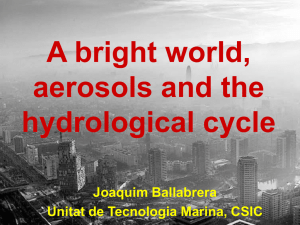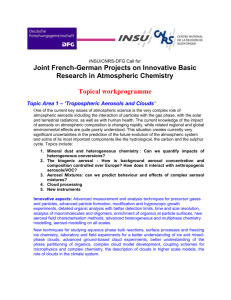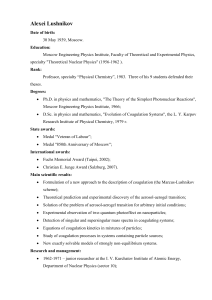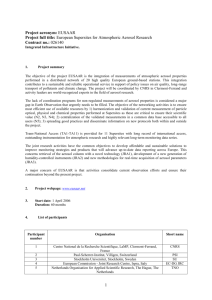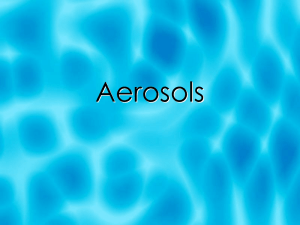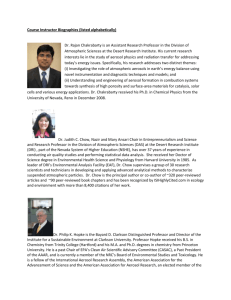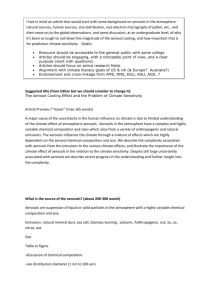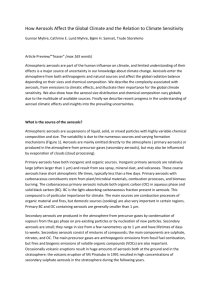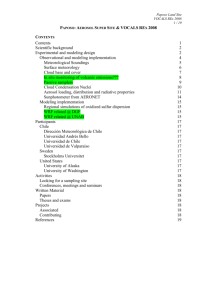PA 3 – Information Sheet
advertisement
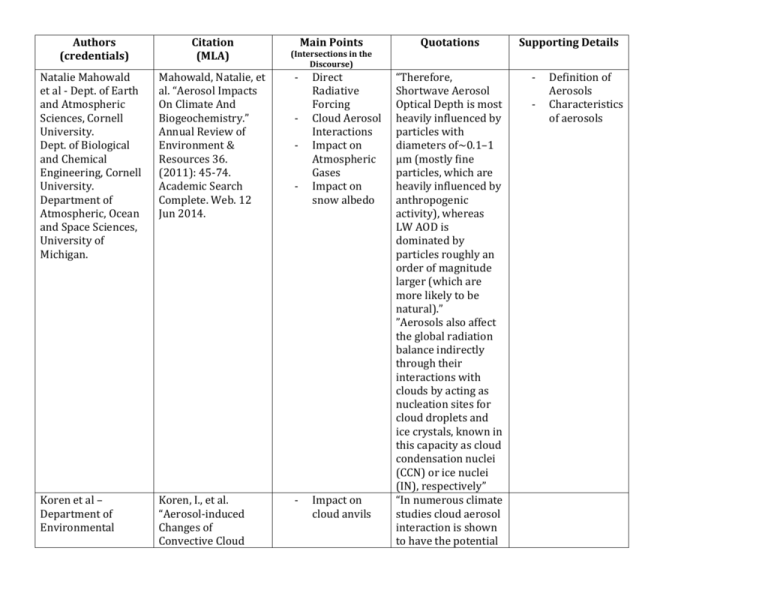
Authors (credentials) Citation (MLA) Main Points Natalie Mahowald et al - Dept. of Earth and Atmospheric Sciences, Cornell University. Dept. of Biological and Chemical Engineering, Cornell University. Department of Atmospheric, Ocean and Space Sciences, University of Michigan. Mahowald, Natalie, et al. “Aerosol Impacts On Climate And Biogeochemistry.” Annual Review of Environment & Resources 36. (2011): 45-74. Academic Search Complete. Web. 12 Jun 2014. - Koren et al – Department of Environmental Koren, I., et al. “Aerosol-induced Changes of Convective Cloud - (Intersections in the Discourse) - Direct Radiative Forcing Cloud Aerosol Interactions Impact on Atmospheric Gases Impact on snow albedo Impact on cloud anvils Quotations “Therefore, Shortwave Aerosol Optical Depth is most heavily influenced by particles with diameters of∼0.1–1 μm (mostly fine particles, which are heavily influenced by anthropogenic activity), whereas LW AOD is dominated by particles roughly an order of magnitude larger (which are more likely to be natural).” ”Aerosols also affect the global radiation balance indirectly through their interactions with clouds by acting as nucleation sites for cloud droplets and ice crystals, known in this capacity as cloud condensation nuclei (CCN) or ice nuclei (IN), respectively” “In numerous climate studies cloud aerosol interaction is shown to have the potential Supporting Details - Definition of Aerosols Characteristics of aerosols Sciences Weizmann Institute, Israel. Laboratory for Atmosphere, NASA Goddard Space Flight Center, MD. Anvils Produce Strong Climate Warming.” Atmospheric Chemistry and Physics 10.10 (2010): 5001-5010. Academic Search Complete. Web. 12 Jun 2014. Mickley et al – School of Engineering and Applied Sciences, Harvard University. Dept. of Earth, Atmospheric and Planetary Sciences, MIT. Goddard Institute for Space Studies, NY. Mickley, L.J., et al. “Regional Warming From Aerosol Removal Over the United States: Results from a Transient 2010–2050 Climate Simulation.” Atmospheric Environment 46. (2012): 545-553. Academic Search Complete. Web. 12 Jun 2014. Paeth, Heiko, and Johann Feichter. “Greenhouse-Gas Versus Aerosol Forcing and African Climate Response.” Climate Dynamics 26.1 (2006): 35-54. Academic Search Complete. Web. 12Jun 2014. Paeth, H. – Meteorological Institute, University of Bonn, Germany. Feichter J. – MaxPlanck-Institute for Meteorology, Hamburg, Germany. - Cooling Effects of Aerosols: removal causing warming - Decrease in solar irradiation (Direct radiative effects) Effect of aerosols in the tropics (low latitudes) - to be a key contributor to the radiative forcing (see Heintzenberg and Charlson (2009) for detailed information). Small changes in the cloud shape, structure or lifetime can change significantly the local radiative balance.” “Although we calculate a much weaker surface aerosol forcing over the United States in our model,…we find that removal of US aerosol leads to significant regional warming, with annual mean surface temperatures increasing...” “Enhanced atmospheric aerosol burden, which primarily arises from biomass burning in this region, leads to a weakening of the rainy season due to reduced heat fluxes and modified microphysical cloud properties.” Chang-Keun Song et al - Department of Atmospheric and Oceanic Sciences and Joint Institute for Regional Earth System Science and Engineering, University of California Los Angeles. School of Earth and Environmental Sciences, Seoul National University, Seoul, Republic of Korea. Chang-Keun Song, et al. “Direct and SemiDirect Radiative Effects of Anthropogenic Aerosols in The Western United States: Seasonal and Geographical Variations According to Regional Climate Characteristics.” Climatic Change 111.3/4 (2012): 859877. Academic Search Complete. Web. 12 Jun 2014. - Andreae et al - Max Planck Institute for Chemistry, Germany. Andreae, Meinrat O., Chris D. Jones, and Peter M. Cox. "Strong Present-Day Aerosol - - Radiative effects on radiative transfer Effects on cloud fields Direct Radiative Effects “The consideration of aerosol emissions induces a remarkable decrease in shortwave solar irradiation near the surface, especially in winter and autumn in tropical West Africa and the Congo Basin where bio- mass burning is mainly prevailing.” “The magnitude of the radiative effect on Outgoing Shortwave Radiation Transfer by the total anthropogenic aerosols is largest in summer.” “Considering the difference in the type of convective clouds between the two regions, the results show that the effect of shortwavescattering sulfates tends to reduce cumulus clouds driven by strong convection as found in previous studies.” “All aerosol types (sulphates, organics, mineral dust, sea salt, and so on) intercept Hadley Centre for Climate Prediction and Research, UK. Cooling Implies a Hot Future." Nature 435.7046 (2005): 1187-1190. Academic Search Complete. Web. 1 June 2013. - Roeckner et al - Max Planck Institute for Meteorology, Hamburg, Germany. California Institute of Technology, Pasadena, USA. Roeckner E., et al. "Impact Of Carbonaceous Aerosol Emissions on Regional Climate Change." Climate Dynamics 27.6 (2006): 553-571. - Cooling effects incoming sunlight, of aerosols and reduce the energy flux arriving at the Earth’s surface, thus producing a cooling. Some aerosols (for example, soot) absorb light and thereby warm the atmosphere, but also cool the surface. This warming of atmospheric layers may also reduce cloudiness, yielding another warming effect. In addition to these ‘direct’ radiative effects, there are several ‘indirect’, cloudmediated effects of aerosols, which all result in cooling: more aerosols produce more, but smaller, droplets in a given cloud, making it more reflective.” Effect of “According to these carbonaceous experiments the aerosols in impact of projected low latitudes changes in carbonaceous aerosols on the global mean temperature is Institute for the Environment and Sustainability, European Commission Joint Research Centre, Ispra, Italy. Academic Search Complete. Web. 3 June 2013. negligible, but significant changes are found at low latitudes. This includes a cooling of the surface, enhanced precipitation and runoff, and a wetter surface.” Fischer-Bruns et al – Max Planck Institute for Meteorology, Hamburg, Germany. International Max Planck Research School on Earth System Modelling, Hamburg, Germany. Fischer-Bruns, Irene, Dorothea Banse, and Johann Feichter. "Future Impact of Anthropogenic Sulfate Aerosol on North Atlantic Climate." Climate Dynamics 32.4 (2009): 511-524. Academic Search Complete. Web. 3 June 2013. - Effect of sulfate aerosols on radiative forcing Alt: Murphy et al Chemical Sciences Division, Earth System Research Laboratory, NOAA, Boulder, Colorado, USA. School of Earth and Environment, Murphy, D.M., et al. “An Observationally Based Energy Balance for the Earth since 1950.” Journal of Geophysical Research: Atmospheres 114.D17 (2009): - Different causes of climate forcing from the 1950s. “The radiative forcing due to the sulfate aerosol’s backscattering of sunlight is known to modify the anthropogenic greenhouse effect significantly, namely to oppose global warming. This fact has been demonstrated by introducing sulfate aerosol into climate models.” “The change in the energy budget due to aerosols is left as the residual between these observed terms largely because of the uncertainty in their indirect effects on clouds. Although University of Leeds, Leeds, UK. NASA Langley Research Center, Hampton, Virginia, USA. D17.107 Academic Search Complete. Web. 1 June 2013. some estimates have been made from satellite data over limited periods, these are subject to large uncertainties and are not available over the multi- decadal timescales of interest here.”

